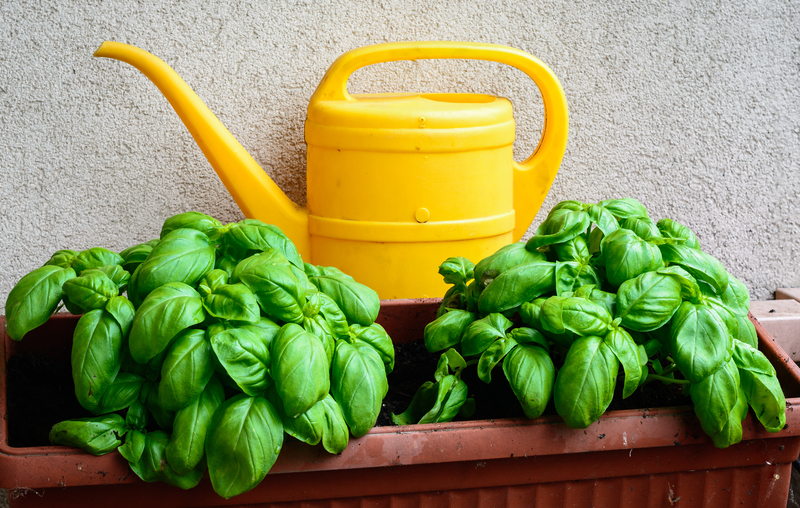Designing a Safe and Fun Garden for Kids
Posted on 23/08/2025
Designing a Safe and Fun Garden for Kids: A Comprehensive Guide

Child-friendly gardens offer more than just a play space--they foster curiosity, encourage physical activity, and cultivate a lifelong love for nature. Whether you're a parent, guardian, or educator, effectively designing a garden that's safe and enjoyable for kids requires thoughtful planning and creativity.
This complete guide provides a step-by-step approach to designing a safe and fun garden for kids, packed with inspiring ideas, practical safety tips, and child garden design features. Let's transform your outdoor space into a haven of adventure!

Why Create a Child-Friendly Garden?
Kids thrive outdoors. Playing in the garden helps them build strength, coordination, and confidence, while also supporting learning and well-being. A thoughtfully designed fun garden for children:
- Encourages creative play through diverse landscapes and features
- Teaches responsibility with plant care and nature observation
- Promotes safety by minimizing hazards
- Provides healthy exercise opportunities
- Cultivates a sense of wonder and appreciation for the outdoors
Key Considerations For a Safe and Fun Kid's Garden Design
Balancing safety with fun elements is crucial in garden design for children. Here's what to consider when embarking on your project:
1. Location and Layout
- Visibility: Choose an area that is easily monitored from inside the house, such as near windows or patios.
- Sun and Shade: A mix of sunny and shady spots keeps kids comfortable during various seasons.
- Size matters: Designate distinct zones--play areas, gardening plots, quiet nooks--to support different activities.
2. Safe, Non-Toxic Plant Choices
Some common plants can be harmful if touched or ingested. For kid-safe gardening:
- Research all plant species and avoid toxic varieties like oleander, foxglove, monkshood, and yew.
- Include sensory plants--lamb's ear (soft leaves), mint (fragrant), and sunflowers (tall and striking)
- Fruit and vegetable patches can be exciting; just ensure children know what's safe to eat!
3. Surface Materials
- Soft surfacing: Choose grass, bark mulch, or sand for play areas to cushion falls.
- Avoid sharp-edged rocks, gravel, or splintering wooden surfaces.
- Non-slip paving is essential for paths and patios to prevent trips and falls.
4. Fencing and Boundaries
- Install secure fencing to keep kids in and hazards out.
- Gates should be child-proof with latches high enough that little hands can't access them unaided.
- Natural boundaries (hedges, shrubs) can visually define the play area.
5. Tool Storage and Garden Equipment
- Lock away sharp tools, chemicals, and fertilizers in a childproof shed.
- Provide age-appropriate equipment such as small spades and watering cans for supervised use.
Features That Make a Garden Exciting and Fun for Kids
Safe garden design doesn't mean boring! The best children's gardens spark the imagination and invite exploration. Try incorporating these playful ideas:
1. Creative Play Spaces
- Sandpit or Mud Kitchen: Sensory play stations let children dig, mold, and build. Use untreated timber and cover sandpits when not in use.
- Treehouse or Playhouse: Install a mini-retreat for reading, quiet time, or dramatic play. Ensure it's sturdy and accessed by gentle steps.
- Climbing Structures: Jungle gyms, small climbing walls, or repurposed logs provide physical challenges.
2. Nature Trails and Hidden Paths
- Winding walkways with stepping stones or log slices add adventure and can teach balance.
- Secret trails through tall grasses or shrubs make quests and hide-and-seek irresistible.
3. Sensory and Discovery Areas
- Mini Wildlife Garden: Bird feeders, bee hotels, and butterfly plants attract pollinators and provide learning opportunities about ecosystems.
- Colorful Flower Patches: Use a mix of annuals and perennials for ongoing interest--think marigolds, cosmos, and nasturtiums.
- Water Features: Bubbling fountains or small streams add calming sounds (ensure they're shallow and covered when not supervised).
4. Edible Garden Beds
- Raised beds at child height make planting and harvesting easier and safer.
- Plant crops like cherry tomatoes, strawberries, lettuce, and snap peas for instant snacks.
- Involve children in every stage, from seed sowing to harvesting, to foster connection and ownership.
5. Creative Art Corners
- Chalkboard walls, outdoor easels, or dedicated rock painting stations celebrate creativity in nature.
- Wind chimes, mosaic stepping stones, or clay sculptures can be made by children and integrated into the space.
Prioritizing Safety in Every Aspect of Kids' Garden Design
While fun is the goal, safety in children's gardens must always come first. Here's how to ensure your yard is a secure space for all ages:
Common Hazards to Avoid
- Ponds and deep water features: Children should never be left unsupervised near water. Consider installing a safety cover or creating a dry "riverbed" feature instead.
- Thorny or toxic plants: Regularly check for and remove potentially hazardous greenery.
- Sharp tools and chemicals: Store these out of reach and lock sheds and garages.
- Pesticides and herbicides: Opt for organic gardening methods to eliminate chemical exposure.
- Trip and slip hazards: Keep paths clear and surfaces even.
General Safety Guidelines
- Supervision is crucial--no matter how safe your garden, never leave young children alone outdoors.
- Use non-toxic, splinter-free materials for garden furniture and play equipment.
- Regularly inspect equipment for wear or damage and make repairs promptly.
- Add secure, soft landings under swings, slides, and other structures.
Seasonal Maintenance for a Safe and Fun Kids' Garden
Ongoing care keeps the garden both inviting and secure.
- Spring: Check for winter damage, refresh mulch, and reseed bare spots in the lawn.
- Summer: Monitor plant growth, prune shrubs, and water during droughts--encourage kids to help!
- Autumn: Clear leaf litter, inspect fences and play equipment, and plant bulbs.
- Winter: Store removable features, cover sandpits, and protect young plants.
Designing a Garden That Grows With Your Kids
Your safe and fun garden for children will evolve as they do. Modular features--such as movable beds, interchangeable play areas, and flexible seating--allow for easy updates as children's interests change. Get their input as they mature to keep the space relevant and engaging.
Involving Children in Garden Design
The best kids' gardens are those designed with input from the kids themselves. Planning together teaches valuable skills and builds excitement. Ideas for involving children:
- Let them choose flower colors or crops for edible beds
- Assign a "secret space" for reading or quiet time
- Ask what playground features excite them most
- Encourage them to create garden art projects
Personalizing Your Child-Friendly Garden: Inspiring Themes and Ideas
Add a touch of magic with themed designs! Consider these inspiring concepts:
- Fairy Tale Garden: Fairy doors, tiny bridges, and whimsical paths create a sense of wonder.
- Explorer's Adventure Yard: Hide "treasures" for scavenger hunts with telescopes or binoculars nearby.
- Edible Maze: Grow tall sunflowers or beans as living walls for a maze kids can wander.
- Butterfly Sanctuary: Plant milkweed, lavender, and buddleia to attract pollinators.
- Outdoor Classroom: Set up benches, chalkboards, and labeled plant displays.
Eco-Friendly and Sustainable Kids' Garden Ideas
Teaching children about sustainability is easy in the garden:
- Start a compost bin and let kids help turn it
- Use rain barrels to water plants and track rainfall together
- Make bird feeders from recycled materials
- Plant native species to support local wildlife

Helpful Tips for Maintaining a Vibrant and Safe Kids' Garden
- Rotate toys and play features to maintain interest and challenge.
- Use bright colors and interesting textures to engage all senses.
- Encourage daily or weekly exploration--nature games, scavenger hunts, garden journaling.
- Celebrate seasons with themed plantings, crafts, or gardening "parties."
Final Thoughts: Creating Lifelong Memories in a Safe and Fun Garden
Designing a safe and fun garden for kids is one of the best gifts you can give your family. With careful planning, age-appropriate features, and ongoing maintenance, your outdoor space will become a cherished environment for play, discovery, and growth.
Prioritize safety, invite curiosity, and don't be afraid to get creative. Your child-friendly garden will be a legacy of laughter and learning--right outside your door.
Ready to transform your garden? Start today and watch your children--and your garden--bloom!



